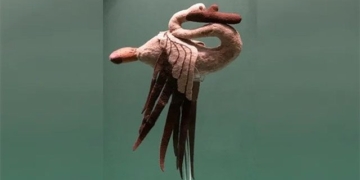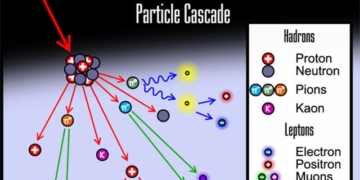When we think of the great inventor Isaac Newton, the story of the “apple falling on his head” that led to the theory of universal gravitation inevitably comes to mind. Not only that, but he also made numerous groundbreaking inventions that changed the world: the three laws of motion, calculus, and the study of light, among others.
At Westminster Abbey, a Latin inscription is engraved on Newton’s tomb: “Hic depositum est, quod mortale fult Isaac Newtoni”, meaning “Here lies a man who once existed and adorned the development of humanity.”
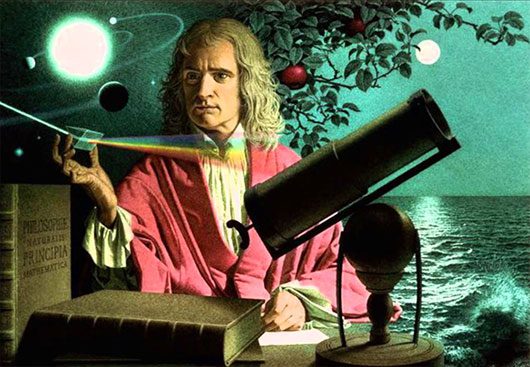
This praise is by no means excessive considering the legacy that the genius Newton has left for mankind. Let’s highlight 10 important and fascinating inventions of Isaac Newton throughout his creative career that we may not often pay attention to.
1. Newton’s Idea of a Cannon Firing into Orbit
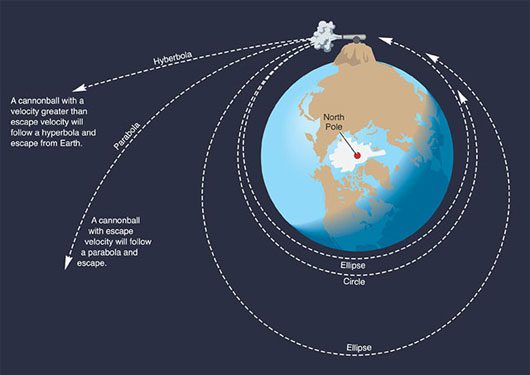
Some may cynically question how a man who was snoring and an apple falling could lead to such a great invention. Is it just the result of “waiting for the fruit to fall”? Not at all; this came from a genius mind constantly pondering the laws of physics, specifically gravity. Newton did not stop at gravity; he proposed many other ideas that were ahead of his time. In his universal law of gravitation, Newton described a massive mountain with its peak above Earth’s atmosphere, on top of which was a colossal cannon capable of firing a projectile horizontally into space.
Newton had no intention of creating a superweapon to shoot down alien invaders! His cannon was a thought experiment designed to explain how to place an object into an orbit around the Earth.
If gravitational force acted on the cannonball, it would follow a trajectory depending on its initial velocity.
- At a low speed, it would simply fall back to Earth. If it reached orbital velocity, it would orbit the Earth in a fixed circular path like the Moon.
- At a speed higher than orbital velocity, but not enough to escape Earth completely (less than escape velocity), it would continue to orbit the Earth along an elliptical path.
- At a very high speed, it would indeed escape orbit and fly into outer space.
This experiment was presented in Principia Mathematica in 1687, stating that all particles exert a gravitational force and are attracted to other objects. This interaction depends on the mass and distance of that particle or object. This principle governs all phenomena, from falling rain to the orbits of planets. This work is renowned for its vital contributions to classical physics and laid the theoretical groundwork for space travel and the development of rockets later on. Subsequently, Einstein and physicists of the 16th and 17th centuries further solidified Newton’s theories, giving us the understanding of gravity we have today.
2. The Pet Door

Not only did Newton have grand ideas like a space cannon and discovering the connections between all things in the universe, but he also applied his brilliant mind to solve everyday problems. A prime example is his method to prevent cats from scratching at the door by creating a dedicated passage for them.
As we know, Newton never married and had few friendships; instead, he chose cats and dogs as companions in his room. Many theories and arguments suggest he cared deeply for his “little friends.” Some contemporary historians claim that Newton was a great animal lover, with some even saying he named a dog Diamond. However, some historians remain skeptical about this claim.
A story recounts that during his research at the University of Cambridge, Newton’s experiments were frequently interrupted by a cat scratching at the laboratory door, creating annoying noises. To resolve the issue, he invited a carpenter from Cambridge to cut two holes in the laboratory door: one large hole for the mother cat and one small hole for the kitten!
Whether this story is true or not, historical records after Newton’s death reveal that a door with two holes matching the sizes of a mother cat and kitten was found. To this day, there remains much debate surrounding this story. However, many still believe that Newton is indeed the inventor of the pet door still in use today.
3. Newton’s Three Laws of Motion

While historians still debate whether the pet door belongs to Newton or not, no one can deny his contributions to our understanding of physics today. Equally important to the discovery of the law of universal gravitation are the three laws of motion that Newton introduced in 1687 in his work Philosophiæ Naturalis Principia Mathematica (Mathematical Principles of Natural Philosophy). His three laws laid a solid foundation for the development of classical mechanics (also known as Newtonian mechanics) in later times.
His three laws are briefly described as follows:
- If an object is not subjected to any net external force, it remains at rest or moves in a straight line at constant speed.
- The acceleration of an object is in the direction of the net force acting on it. The magnitude of the acceleration is directly proportional to the magnitude of the force and inversely proportional to the mass of the object.
- In every interaction, when object A exerts a force on object B, object B exerts an equal and opposite force back on object A. These two forces are equal in magnitude, opposite in direction, and collinear.
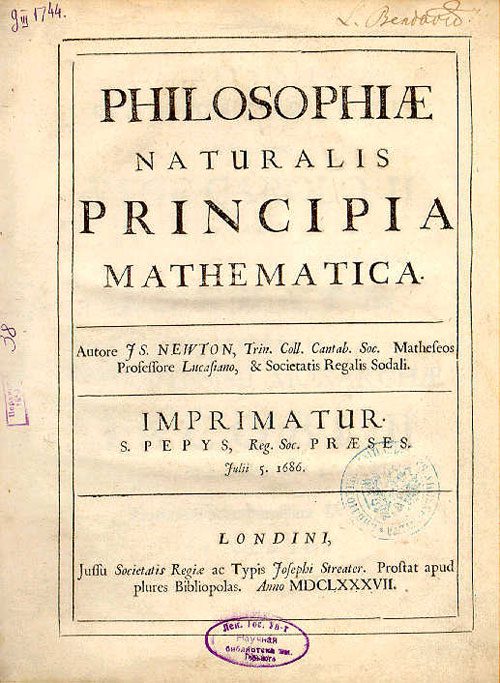
Cover of the book Philosophiæ Naturalis Principia Mathematica published in 1687
Today, we can easily articulate and comprehend the above three famous laws. However, scholars throughout history struggled with basic concepts of motion for centuries. The Greek philosopher Aristotle once believed that smoke could rise because it contained a lot of air. Earlier, other scholars thought that smoke rose to gather with its “friends.” The French philosopher René Descartes considered theories of motion similar to Newton’s but ultimately believed that God was the driving force behind all motion.
Newton’s three laws represent a beauty that comes from simplicity in science. Despite their simplicity, these laws form the basis for scientists to understand everything from the movement of electrons to the spiral motions of galaxies.
4. Newton’s Philosopher’s Stone
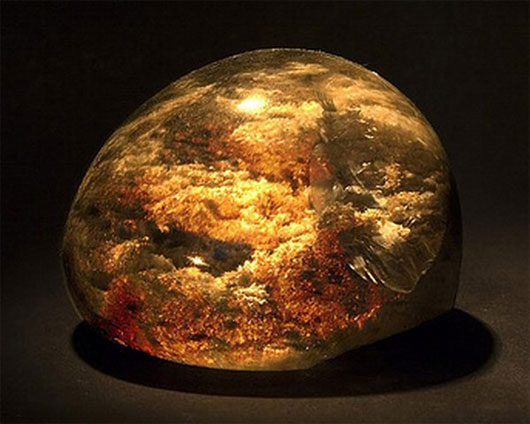
In a drawing of an alchemist, we see planetary symbols depicting metals in an open book on the floor. These are believed to be symbols that Newton used in his notes.
Isaac Newton made significant contributions to humanity through his scientific discoveries. In addition to this, he is also remembered as one of the greatest alchemists: the legendary alchemist associated with the philosopher’s stone. Numerous texts documenting his work, preserved to this day, describe this stone in various ways: from the ability to create humans from stone to the capability of transforming lead into gold. In fact, people at that time believed that his stone could cure diseases or even turn a headless cow into a swarm of bees.
You might wonder why a symbol of science would also be considered an alchemist. To answer this question, it’s essential to think about the context of the time; the scientific revolution had only just reached the steam engine in the 1600s. Alchemists still existed alongside their outdated tricks, theories, and mystical philosophies aimed at enchanting some individuals. Nevertheless, alchemical records are still considered chemical experiments.
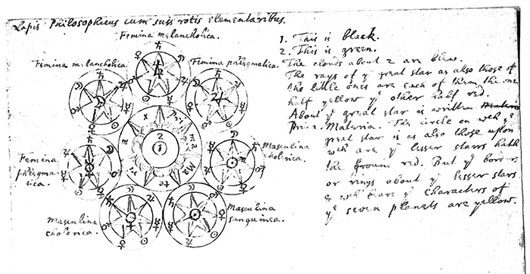
Newton’s handwritten notes on alchemical research
However, the records from Newton’s 30 years of experimentation reveal that he hoped for something beyond ordinary chemical reactions, even promising transformations of other elements into gold. According to historian William Newman, he believes Newton sought to discover “superior powers in nature.”
This serves as a basis for the argument that Newton conducted research and left notes on alchemy, which was contemporarily referred to as the “philosopher’s stone.” The records indicate he attempted to create various mysterious elements of his time. In reality, Newton tried to produce a type of copper alloy with a purple hue. However, his research ultimately failed.
While this may not be an invention of Newton, it provides insight into his thoughts and the time he dedicated to scientific research. In 2005, historian Newman created a “philosopher’s stone” based on Newton’s 300-year-old notes, and of course, no transformation into gold occurred.
5. The Father of Calculus
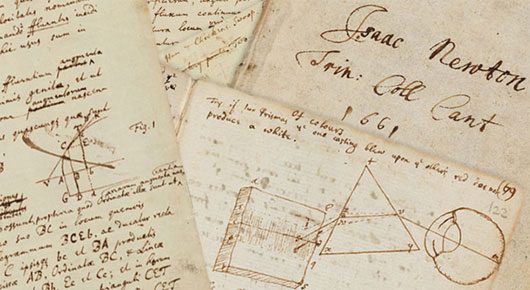
Newton’s surviving manuscripts
If you’ve ever struggled with mathematics, particularly calculus, you might partially blame Newton! In fact, the mathematical system is a tool that enables us to understand everything in this universe. Like many scientists of his time, Newton realized that earlier algebraic and geometric theories were insufficient for his scientific research needs. The contemporary mathematical systems were inadequate for him.
Mathematicians at that time could calculate the speed of a ship, but they could not determine the relationship with its acceleration or the ratio of the force applied. They were still unable to calculate the optimal angle for a cannonball to achieve maximum distance. The mathematicians of the day needed a method to compute functions with multiple variables.
An event occurred during Newton’s research when a plague outbreak caused numerous deaths in the streets of Cambridge. All shops closed, and naturally, Newton had to limit his outings. This period marked 18 months of research for Newton, during which he developed a mathematical model he termed “the science of continuity.”
Today, we recognize this as calculus, an essential tool in physics, economics, and probability sciences. In the 1960s, these calculus functions provided the means for Apollo spacecraft engineers to calculate data for the Moon landing mission.
Of course, Newton did not single-handedly create the calculus we use today. Alongside Newton, the German mathematician Gottfried Leibniz (1646-1716) independently developed a calculus model around the same time. Nevertheless, we must acknowledge Newton’s significant role in the development of modern mathematics due to his substantial contributions.
6. “Giving Birth” to Rainbows
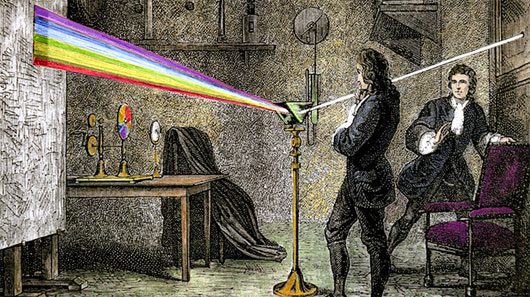
Newton’s experiment
Rainbows? What are rainbows? Did you think Newton left the secrets inside rainbows untouched? Not at all! Our genius was determined to decode the mysteries contained within this natural phenomenon. In 1704, he wrote a book on the subject of light refraction titled “Opticks.” This book played a significant role in changing our understanding of light and color.
Scientists of the time knew that rainbows formed when light was refracted and reflected in raindrops in the atmosphere. However, they could not clearly explain why rainbows contained so many colors. When Newton began his studies at Cambridge, prevailing theories suggested that raindrops somehow dyed different colors onto sunlight.
By using a prism and a lamp, Newton conducted an experiment by allowing light to pass through the prism. The result, as we all know, was that light was separated into colors like those of a rainbow.
7. The Reflecting Telescope
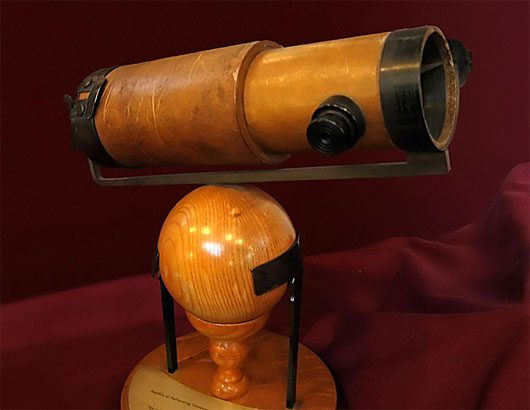
A replica of the reflecting telescope created by Newton presented to the Royal Society in 1672
Newton was born during a time when the presence of telescopes was still quite limited. Nevertheless, scientists had managed to create models using a set of glass lenses to magnify images. In Newton’s experiments with colors, he discovered that different colors refracted at different angles, resulting in a blurred image for the viewer.
To improve image quality, Newton proposed using a reflecting mirror instead of the previous refracting lenses. A large mirror would capture the image, and then a smaller mirror would reflect the captured image to the observer’s eye. This method not only produced clearer images but also allowed for the creation of a smaller telescope.
Some argue that the Scottish mathematician James Gregory was the first to propose the idea of creating a reflecting telescope in 1663, although his model was not fully functional. However, based on preserved records, historians believe Newton was the first to successfully construct a reflecting telescope based on the theory he proposed.
In fact, Newton ground the mirrors himself, assembled a prototype, and presented it to the Royal Society in 1672. It was merely a device measuring 15 cm long, capable of eliminating refraction and magnifying up to 40 times. To this day, nearly all astronomical observatories use variations of Newton’s original design.
8. The Perfect Coin
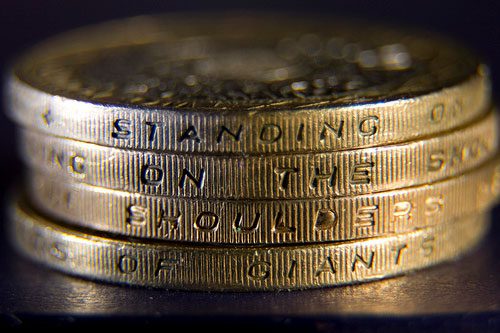
Two-pound coins in the UK with ridges around the edge
In the late 1600s, the financial system in England faced a severe crisis. At that time, the entire monetary system of England relied on silver coins, and naturally, silver itself was worth more than the face value printed on each coin. This led to a problem where some people would shave off the silver content and add other metals during the minting process. The shaved-off silver would then be “bleeding” into France through the border to be sold at a higher price.
At that time, there was even a crisis over the competition to secure contracts for minting coins. As a result, public trust in the financial system severely declined. Simultaneously, criminal organizations involved in counterfeiting flourished due to the absence of a reliable standard currency in circulation. Furthermore, fraud occurred even during the minting process. After each batch of coins was minted, each coin was weighed to check how much it deviated from the standard. If the excess silver value exceeded the printed value, speculators would buy these coins, melt them down, and sell them back to the mint for profit.
In response to this situation, in 1696, the British government called upon Isaac Newton to find a solution to combat the counterfeiting and clipping of silver coins. Newton took the bold step of recalling all coins across the country, melting them down, and minting them according to a new design of his own. This move rendered England without circulating currency for an entire year.
During that time, Newton worked tirelessly for 18 hours a day, ultimately resulting in the creation of the new coin design. The newly minted coins featured higher silver quality, and the edges of each coin were milled according to a special formula. Without specialized milling machines, it would have been impossible to produce coins with the unique characteristics recognized as Royal Mint issues.
9. Heat Loss
In his studies, Newton also dedicated considerable time to exploring the physical aspects of the cooling of substances. By the late 1700s, he conducted experiments with red-hot iron spheres. He noted in his records that there was a temperature difference between the iron ball and the surrounding air, specifically a difference of up to 10 degrees Celsius. He also observed that the rate of heat loss was proportional to the temperature difference.
From this, Newton formulated the law of cooling. According to this law, the rate of heat loss from an object is proportional to the temperature difference between the object and its surrounding environment. Later, the French chemist Pierre Dulong and physicist Alexis Petit refined this law in 1817, building upon Newton’s research. Newton’s principles laid the groundwork for many subsequent studies in modern physics, from safe nuclear reactions to space exploration.
10. Newton’s Prediction of the Apocalypse
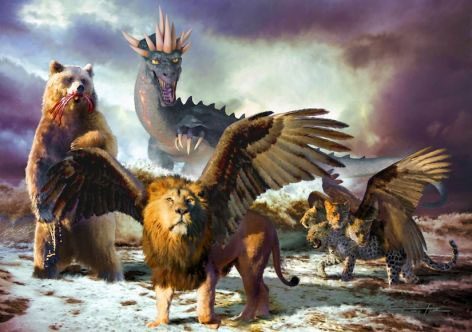
Illustration of the four beasts appearing on the Day of Judgment described in the Book of Daniel
The apocalypse has always haunted humanity. However, Newton was not the type to easily accept the fear of the end of the world through stories or legends. He was a practical thinker, always seeking to validate and express his viewpoints through the study of the Bible.
During his research, Newton did not place a heavy emphasis on theological aspects but instead used his knowledge to attempt to explain the issues. Records from 300 years ago, preserved to this day, indicate that Newton studied the Book of Daniel. To aid in his research, he taught himself Hebrew and focused on studying Jewish mystical philosophy.
Through his research, he predicted that the end of the world would occur in 2060 or possibly later, but not sooner. Regardless, this was his proclamation to the world in the 18th century. Today, scientists have better explanations or predictions regarding apocalyptic phenomena in general. Through this, we gain a deeper understanding of the perspective of a scientist from the 18th century on the end of humanity.
















































